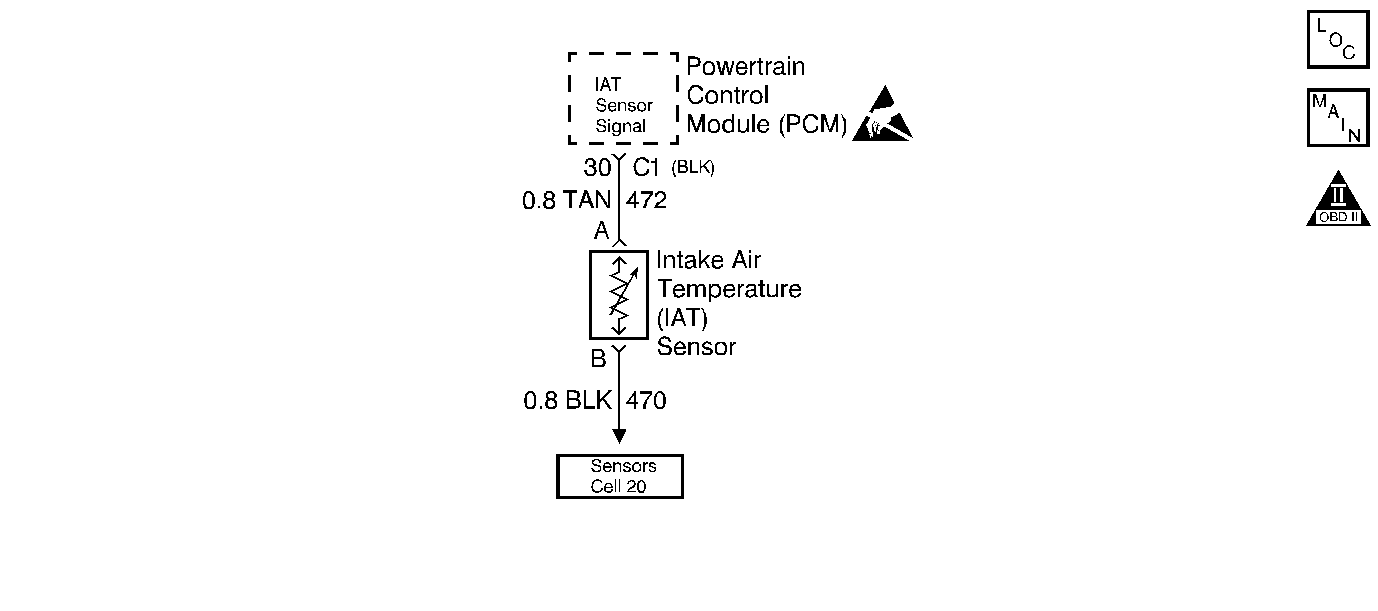
Circuit Description
The Intake Air Temperature (IAT) sensor is a thermistor which controls the signal voltage to the PCM. The PCM supplies a 5V reference and a ground to the sensor. When the air is cold, the resistance will be high. Whenever the intake air is warm, the resistance will be low.
Conditions for Setting the DTC
| • | The engine run time is greater than 320 seconds. |
| • | The vehicle speed sensor indicates that vehicle speed is greater than 15 mph (24 km/h). |
| • | The IAT sensor signal voltage indicates that the intake air temperature is greater than 128°C (262°F). |
Action Taken When the DTC Sets
| • | The Malfunction Indicator Lamp (MIL) illuminates. |
| • | The PCM records the operating conditions at the time the diagnostic fails. The Freeze Frame and Failure Records buffers stores this information. |
| • | A history DTC is stored. |
| • | The PCM will default to 60°C for intake air temperature. The scan tool will not show the defaulted value. |
Conditions for Clearing the MIL/DTC
| • | The malfunction indicator lamp (MIL) will turn OFF after 3 consecutive ignition cycles in which the diagnostic runs without a fault. |
| • | A history DTC will clear after 40 consecutive warm up cycles without a fault. |
| • | Use a scan tool to clear the DTCs. |
Diagnostic Aids
| • | When the vehicle is at ambient temperature, compare the IAT sensor to the ECT sensor. The IAT sensor and the ECT sensor should be relatively close to each other. |
| • | Use the Temperature vs Resistance Values Table below to evaluate the possibility of a skewed sensor. Refer to Temperature vs Resistance . |
Test Description
The numbers below refer to the step numbers on the diagnostic table.
-
The Powertrain OBD System Check prompts the technician to complete some basic checks and store the Freeze Frame Data and the Failure records on the scan tool if applicable. This creates an electronic copy of the data taken when the fault occurred. This information on the scan tool can be referred to later.
-
Before replacing the PCM, check terminals for improper mating, broken locks, or physical damage to the wiring harness. Reprogram the replacement PCM. Refer to the latest Techline information for programming procedures.
Step | Action | Value(s) | Yes | No |
|---|---|---|---|---|
Was the Powertrain On-Board Diagnostic (OBD) System Check performed? | -- | |||
2 |
Is the IAT sensor value greater than the specified value? | 128° C (262° F) | ||
3 |
Is the IAT sensor value greater than the specified value? | 128° C 262° F) | Go to the Diagnostic Aids | |
4 | Disconnect the IAT sensor electrical connector. Is the IAT sensor value lower than the specified value? | -30° C (-22° F) | ||
5 | Replace the IAT sensor. Refer to Intake Air Temperature Sensor Replacement . Is the action complete? | -- | -- | |
6 | With a test lamp connected to B+ probe the IAT sensor signal circuit at the IAT sensor electrical connector. Does the test lamp turn ON? | -- | ||
7 | Repair the short to ground in the IAT signal circuit. Refer to Wiring Repairs in Engine Electrical. Is the action complete? | -- | -- | |
Replace the PCM. Refer to Powertrain Control Module Replacement/Programming . Is the action complete? | -- | -- | ||
9 |
Does the scan tool indicate that this diagnostic ran and passed? | 90°-95° C | ||
10 | Check if any additional DTCs are set. Are any DTCs displayed that have not been diagnosed? | -- | Go to the Applicable DTC Table | System OK |
